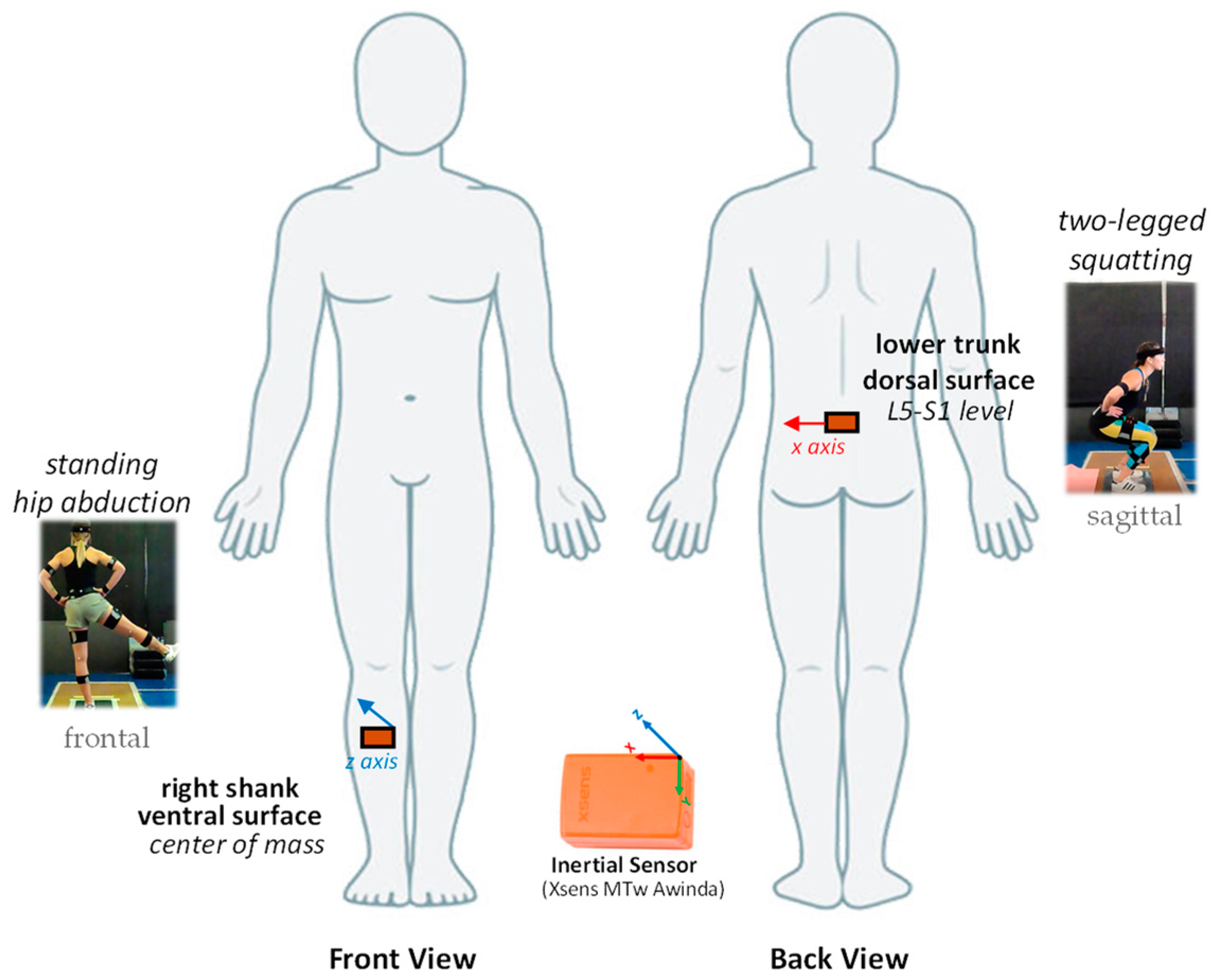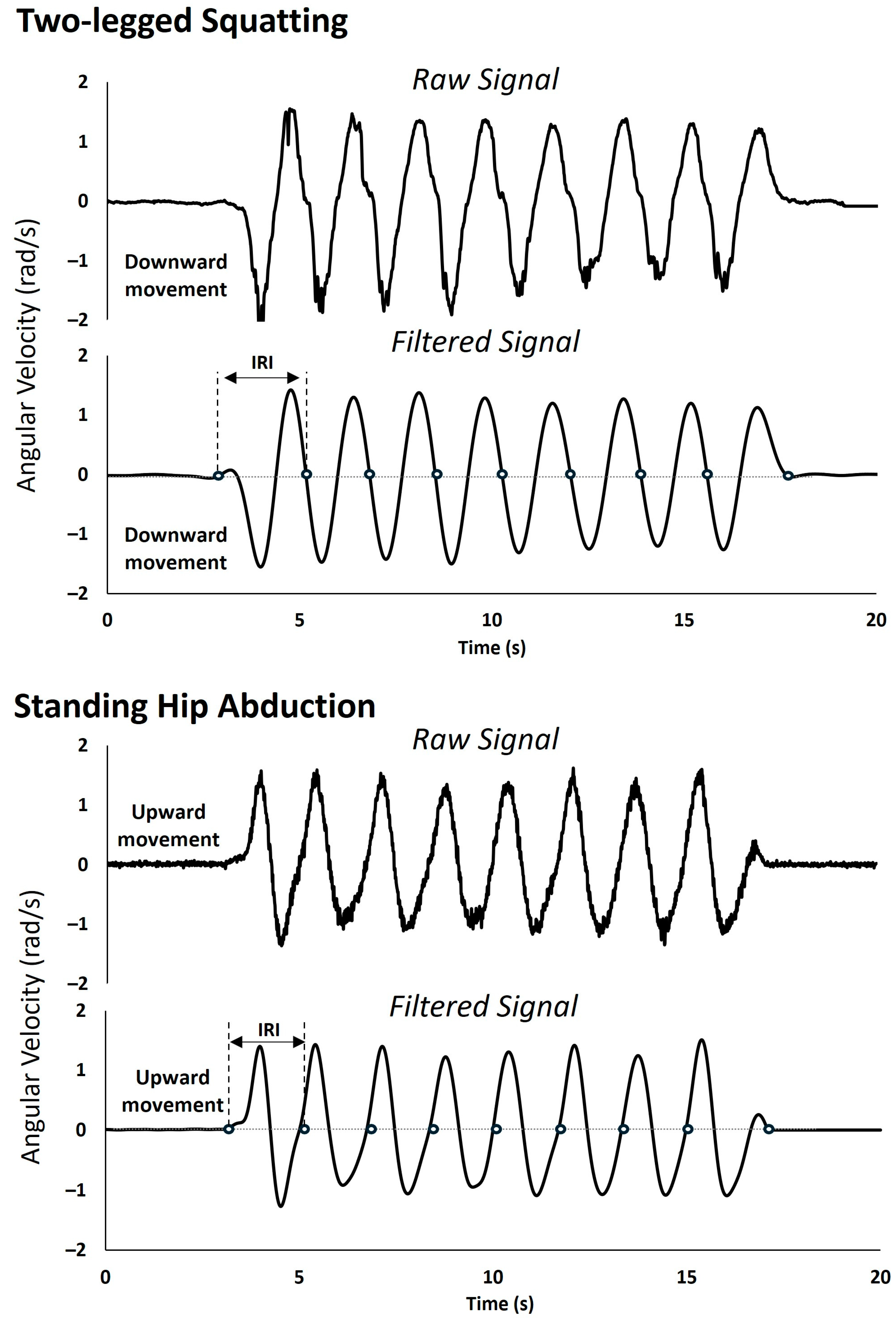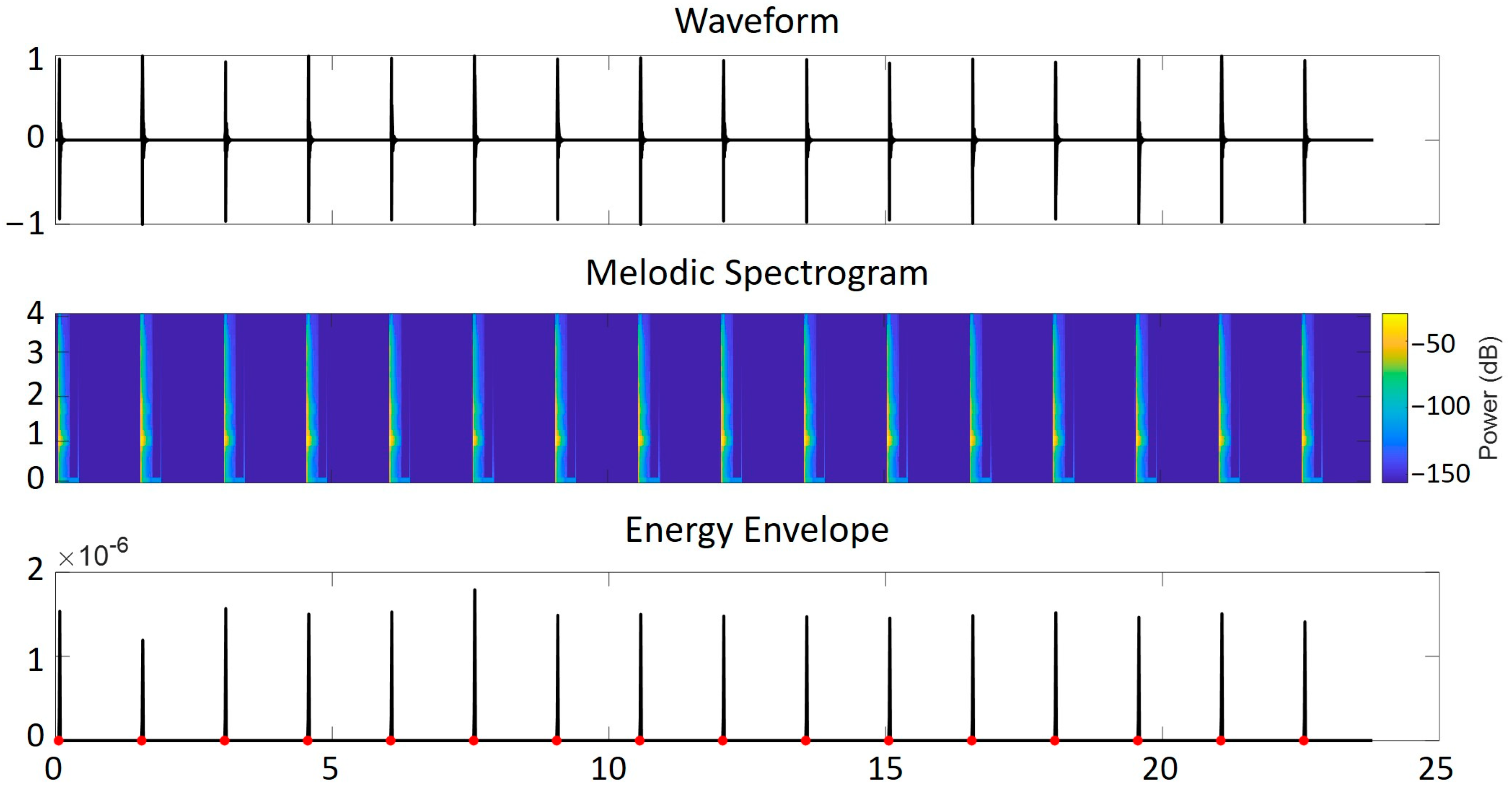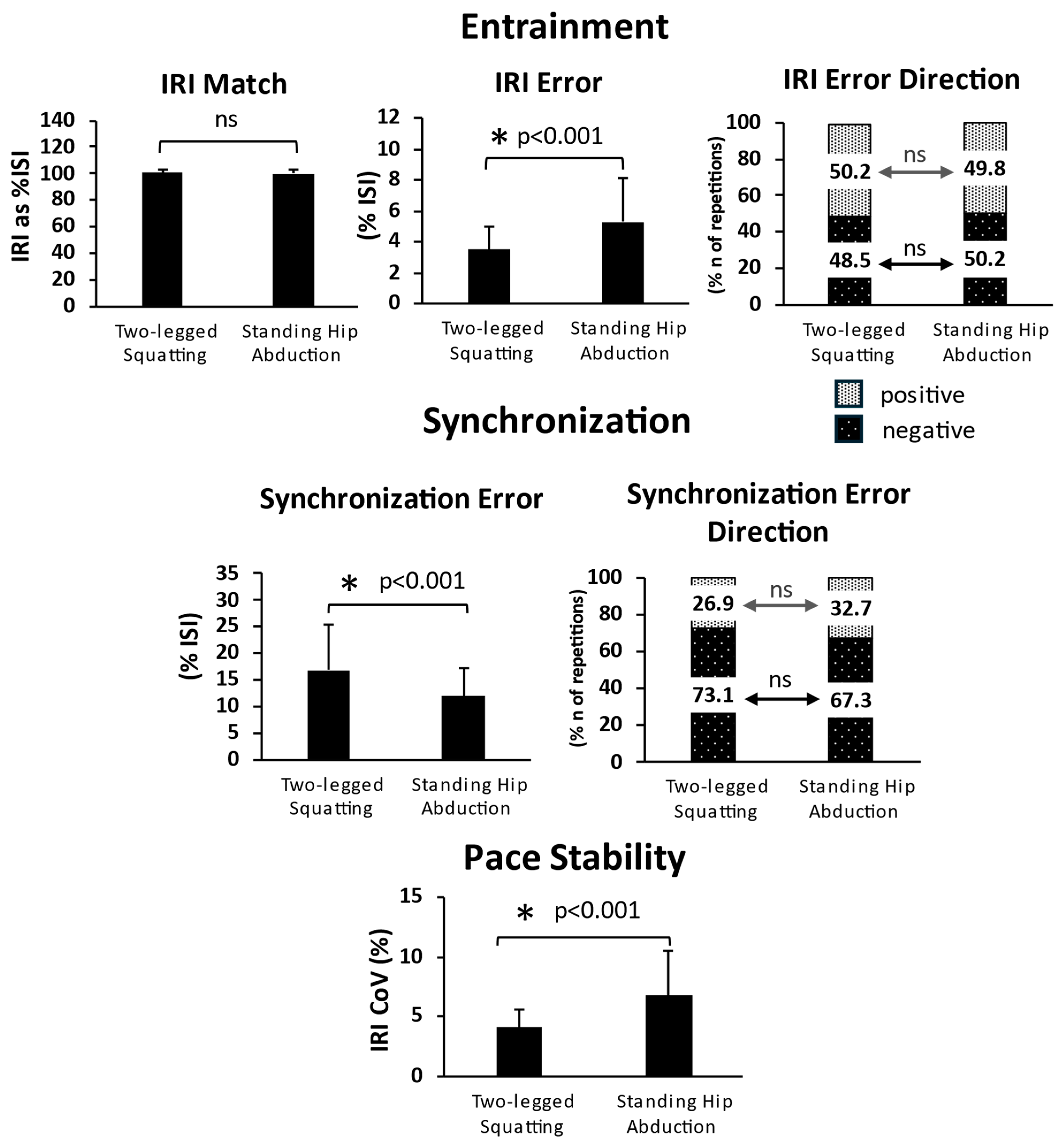Beyond Simple Tapping: Is Timed Body Movement Influenced When Balance Is Threatened?
Abstract
1. Introduction
2. Materials and Methods
2.1. Participants
2.2. Experimental Procedure
2.3. Timing Data Recording—Instrumentation
2.4. Data Procession and Analysis
2.4.1. Inter-Response Interval (IRI) Estimation
2.4.2. Metronome Beat Detection
2.4.3. Calculation of Timing Variables
Entrainment Variables
Synchronization Variables
Pace Stability
2.5. Statistical Analysis
3. Results
3.1. Inter-Response Interval (IRI)
3.2. Entrainment
3.3. Synchronization
3.4. Pace Stability
4. Discussion
Author Contributions
Funding
Institutional Review Board Statement
Informed Consent Statement
Data Availability Statement
Acknowledgments
Conflicts of Interest
Appendix A
Appendix B

References
- Bood, R.J.; Nijssen, M.; Van Der Kamp, J.; Roerdink, M. The Power of Auditory-Motor Synchronization in Sports: Enhancing Running Performance by Coupling Cadence with the Right Beats. PLoS ONE 2013, 8, e70758. [Google Scholar] [CrossRef] [PubMed]
- Rodger, M.W.M.; Craig, C.M. Timing Movements to Interval Durations Specified by Discrete or Continuous Sounds. Exp. Brain Res. 2011, 214, 393–402. [Google Scholar] [CrossRef] [PubMed]
- Schaffert, N.; Janzen, T.B.; Mattes, K.; Thaut, M.H. A Review on the Relationship between Sound and Movement in Sports and Rehabilitation. Front. Psychol. 2019, 10, 244. [Google Scholar] [CrossRef] [PubMed]
- Thaut, M.H.; Miller, R.A.; Schauer, L.M. Multiple Synchronization Strategies in Rhythmic Sensorimotor Tasks: Phase vs Period Correction. Biol. Cybern. 1998, 79, 241–250. [Google Scholar] [CrossRef] [PubMed]
- Rose, D.; Ott, L.; Guérin, S.M.R.; Annett, L.E.; Lovatt, P.; Delevoye-Turrell, Y.N. A General Procedure to Measure the Pacing of Body Movements Timed to Music and Metronome in Younger and Older Adults. Sci. Rep. 2021, 11, 3264. [Google Scholar] [CrossRef]
- Rose, D.; Delevoye-Turrell, Y.; Ott, L.; Annett, L.E.; Lovatt, P.J. Music and Metronomes Differentially Impact Motor Timing in People with and without Parkinson’s Disease: Effects of Slow, Medium, and Fast Tempi on Entrainment and Synchronization Performances in Finger Tapping, Toe Tapping, and Stepping on the Spot Tasks. Parkinson’s Dis. 2019, 2019, 1–18. [Google Scholar] [CrossRef]
- Merker, B.H.; Madison, G.S.; Eckerdal, P. On the Role and Origin of Isochrony in Human Rhythmic Entrainment. Cortex 2009, 45, 4–17. [Google Scholar] [CrossRef]
- Repp, B.H. Sensorimotor Synchronization: A Review of the Tapping Literature. Psychon. Bull. Rev. 2005, 12, 969–992. [Google Scholar] [CrossRef]
- Wilquin, H.; Delevoye-Turrell, Y.; Dione, M.; Giersch, A. Motor Synchronization in Patients with Schizophrenia: Preserved Time Representation with Abnormalities in Predictive Timing. Front. Hum. Neurosci. 2018, 12, 193. [Google Scholar] [CrossRef]
- Aschersleben, G. Temporal Control of Movements in Sensorimotor Synchronization. Brain Cogn. 2002, 48, 66–79. [Google Scholar] [CrossRef]
- Bieńkiewicz, M.M.N.; Rodger, M.W.M.; Craig, C.M. Timekeeping Strategies Operate Independently from Spatial and Accuracy Demands in Beat-Interception Movements. Exp. Brain Res. 2012, 222, 241–253. [Google Scholar] [CrossRef] [PubMed]
- Semjen, A.; Schulze, H.H.; Vorberg, D. Timing Precision in Continuation and Synchronization Tapping. Psychol. Res. 2000, 63, 137–147. [Google Scholar] [CrossRef] [PubMed]
- Zelaznik, H.N.; Spencer, R.M.C.; Ivry, R.B. Dissociation of Explicit and Implicit Timing in Repetitive Tapping and Drawing Movements. J. Exp. Psychol. Hum. Percept. Perform. 2002, 28, 575–588. [Google Scholar] [CrossRef] [PubMed]
- Spencer, R.M.C.; Zelaznik, H.N.; Diedrichsen, J.; Ivry, R.B. Disrupted Timing of Discontinuous but Not Continuous Movements by Cerebellar Lesions. Science 2003, 300, 1437–1439. [Google Scholar] [CrossRef] [PubMed]
- Wright, R.L.; Spurgeon, L.C.; Elliott, M.T. Corrigendum: Stepping to phase-perturbed metronome cues: Multisensory advantage in movement synchrony but not Correction. Front. Hum. Neurosci. 2015, 9, 441. [Google Scholar] [CrossRef]
- Chen, H.-Y.; Wing, A.M.; Pratt, D. The Synchronisation of Lower Limb Responses with a Variable Metronome: The Effect of Biomechanical Constraints on Timing. Gait Posture 2006, 23, 307–314. [Google Scholar] [CrossRef]
- Gabbard, C.; Hart, S. Effects of Standing and Sitting on Finger-Tapping Speed in Healthy Adults. J. Orthop. Sports Phys. Ther. 2002, 32, 525–529. [Google Scholar] [CrossRef][Green Version]
- Grgic, J.; Schoenfeld, B.J.; Skrepnik, M.; Davies, T.B.; Mikulic, P. Effects of Rest Interval Duration in Resistance Training on Measures of Muscular Strength: A Systematic Review. Sports Med. 2018, 48, 137–151. [Google Scholar] [CrossRef]
- Emmanouil, A.; Rousanoglou, E.; Boudolos, K. Two Repetitions May Be Enough! Reliability of Movement Timing in Physical Fitness Exercises Performed by Young, Trained Adults Using Inertial Sensors. Biomechanics 2024, 4, 84–108. [Google Scholar] [CrossRef]
- Fleiss, J.L. The Design and Analysis of Clinical Experiments; Willey: New York, NY, USA, 1986. [Google Scholar]
- Soulard, J.; Vaillant, J.; Balaguier, R.; Vuillerme, N. Spatio-Temporal Gait Parameters Obtained from Foot-Worn Inertial Sensors Are Reliable in Healthy Adults in Single- and Dual-Task Conditions. Sci. Rep. 2021, 11, 10229. [Google Scholar] [CrossRef]
- Pedersen, B.S.; Kristensen, M.T.; Josefsen, C.O.; Lykkegaard, K.L.; Jønsson, L.R.; Pedersen, M.M. Validation of Two Activity Monitors in Slow and Fast Walking Hospitalized Patients. Rehabil. Res. Pract. 2022, 2022, 1–14. [Google Scholar] [CrossRef] [PubMed]
- Atkinson, G.; Nevill, A.M. Statistical Methods for Assessing Measurement Error (Reliability) in Variables Relevant to Sports Medicine. Sports Med. 1998, 26, 217–238. [Google Scholar] [CrossRef] [PubMed]
- Kribus-Shmiel, L.; Zeilig, G.; Sokolovski, B.; Plotnik, M. How Many Strides Are Required for a Reliable Estimation of Temporal Gait Parameters? Implementation of a New Algorithm on the Phase Coordination Index. PLoS ONE 2018, 13, e0192049. [Google Scholar] [CrossRef] [PubMed]
- Yoke, M.M.; Armbruster, C. Applying Music Skills in Group Exercise: Beat-Based Techniques. In Methods of Group Exercise Instruction, 4th ed.; Human Kinetics: Champaign, IL, USA, 2019; pp. 51–75. [Google Scholar]
- Paulich, M.; Schepers, M.; Rudigkeit, N.; Bellusci, G. Xsens MTw Awinda: Miniature Wireless Inertial-Magnetic Motion Tracker for Highly Accurate 3D Kinematic Applications; MTw A Awinda Whitepaper—MW0404P.A; Xsens Technologies B.V.: Enschede, The Netherlands, 2018. [Google Scholar] [CrossRef]
- Berglund, B.; Lindvall, T.; Shwela, D.H. Guidelines for Community Noise; World Health Organization: Geneva, Switzerland, 1999; Available online: https://www.who.int/publications/i/item/a68672 (accessed on 1 July 2024).
- Stevens, S.S.; Volkman, J.; Newman, E.B. A Scale for the Measurement of the Psychological Magnitude Pitch. J. Acoust. Soc. Am. 1937, 8, 185–190. [Google Scholar] [CrossRef]
- Cohen, J. Statistical Power Analysis for the Behavioral Sciences; Routledge Academic: New York, NY, USA, 1988. [Google Scholar]
- Fein, E.C.; Gilmour, J.; Machin, T.; Hendry, L. Statistics for Research Students: An Open Access Resource with Self-Tests and Illustrative Examples; University of Southern Queensland: Brisbane, Australia, 2022; Available online: https://open.umn.edu/opentextbooks/textbooks/1191 (accessed on 1 July 2024).
- Peckel, M.; Pozzo, T.; Bigand, E. The Impact of the Perception of Rhythmic Music on Self-Paced Oscillatory Movements. Front. Psychol. 2014, 5, 1037. [Google Scholar] [CrossRef]
- Maki, B.E.; McIlroy, W.E. The Role of Limb Movements in Maintaining Upright Stance: The “Change-in-Support” Strategy. Phys. Ther. 1997, 77, 488–507. [Google Scholar] [CrossRef]
- Varlet, M.; Williams, R.A.; Keller, P.E. Effects of Pitch and Tempo of Auditory Rhythms on Spontaneous Movement Entrainment and Stabilisation. Psychol. Res. 2020, 84, 568–584. [Google Scholar] [CrossRef]
- Bouvet, C.J.; Varlet, M.; Bella, S.D.; Keller, P.E.; Zelic, G.; Bardy, B.G. Preferred Frequency Ratios for Spontaneous Auditory-Motor Synchronization: Dynamical Stability and Hysteresis. Acta Psychol. 2019, 196, 33–41. [Google Scholar] [CrossRef]
- Burger, B.; Thompson, M.R.; Luck, G.; Saarikallio, S.H.; Toiviainen, P. Hunting for the Beat in the Body: On Period and Phase Locking in Music-Induced Movement. Front. Hum. Neurosci. 2014, 8, 903. [Google Scholar] [CrossRef]
- Roerdink, M.; Bank, P.J.M.; Peper, C.E.; Beek, P.J. Walking to the Beat of Different Drums: Practical Implications for the Use of Acoustic Rhythms in Gait Rehabilitation. Gait Posture 2011, 33, 690–694. [Google Scholar] [CrossRef]
- Hamacher, D.; Zech, A. Development of Functional Variability during the Motor Learning Process of a Complex Cyclic Movement. J. Biomech. 2018, 77, 124–130. [Google Scholar] [CrossRef] [PubMed]
- Repp, B.H.; Keller, P.E. Adaptation to Tempo Changes in Sensorimotor Synchronization: Effects of Intention, Attention, and Awareness. Q. J. Exp. Psychol. Sect. A 2004, 57, 499–521. [Google Scholar] [CrossRef] [PubMed]
- Cowin, J.; Nimphius, S.; Fell, J.; Culhane, P.; Schmidt, M. A Proposed Framework to Describe Movement Variability within Sporting Tasks: A Scoping Review. Sports Med. 2022, 8, 85. [Google Scholar] [CrossRef] [PubMed]
- Angelidis, A.; Solis, E.; Lautenbach, F.; Van Der Does, W.; Putman, P. I’m Going to Fail! Acute Cognitive Performance Anxiety Increases Threat-Interference and Impairs WM Performance. PLoS ONE 2019, 14, e0210824. [Google Scholar] [CrossRef] [PubMed]
- Van Der Steen, M.C.; Keller, P.E. The ADaptation and Anticipation Model (ADAM) of Sensorimotor Synchronization. Front. Hum. Neurosci. 2013, 7, 253. [Google Scholar] [CrossRef] [PubMed]
- Miyake, Y.; Onishi, Y.; Pöppel, E. Two Types of Anticipation in Synchronization Tapping. Acta Neurobiol. Exp. 2004, 64, 415–426. [Google Scholar] [CrossRef] [PubMed]
- Repp, B.H.; Su, Y.-H. Sensorimotor Synchronization: A Review of Recent Research (2006–2012). Psychon. Bull. Rev. 2013, 20, 403–452. [Google Scholar] [CrossRef]
- Guérin, S.M.R.; Boitout, J.; Delevoye-Turrell, Y.N. Attention Guides the Motor-Timing Strategies in Finger-Tapping Tasks When Moving Fast and Slow. Front. Psychol. 2021, 11, 574396. [Google Scholar] [CrossRef]
- Gagnon, K.T.; Geuss, M.N.; Stefanucci, J.K. Fear Influences Perceived Reaching to Targets in Audition, but Not Vision. Evol. Hum. Behav. 2013, 34, 49–54. [Google Scholar] [CrossRef]
- Fan, H.; Kong, L.-W.; Lai, Y.-C.; Wang, X. Anticipating Synchronization with Machine Learning. Phys. Rev. Res. 2021, 3, 023237. [Google Scholar] [CrossRef]





| Two-Legged Squatting | Standing Hip Abduction |
|---|---|
|
|
|
|
|
|
|
|
|
Disclaimer/Publisher’s Note: The statements, opinions and data contained in all publications are solely those of the individual author(s) and contributor(s) and not of MDPI and/or the editor(s). MDPI and/or the editor(s) disclaim responsibility for any injury to people or property resulting from any ideas, methods, instructions or products referred to in the content. |
© 2024 by the authors. Licensee MDPI, Basel, Switzerland. This article is an open access article distributed under the terms and conditions of the Creative Commons Attribution (CC BY) license (https://creativecommons.org/licenses/by/4.0/).
Share and Cite
Emmanouil, A.; Boudolos, K.; Rousanoglou, E. Beyond Simple Tapping: Is Timed Body Movement Influenced When Balance Is Threatened? Appl. Sci. 2024, 14, 8541. https://doi.org/10.3390/app14188541
Emmanouil A, Boudolos K, Rousanoglou E. Beyond Simple Tapping: Is Timed Body Movement Influenced When Balance Is Threatened? Applied Sciences. 2024; 14(18):8541. https://doi.org/10.3390/app14188541
Chicago/Turabian StyleEmmanouil, Analina, Konstantinos Boudolos, and Elissavet Rousanoglou. 2024. "Beyond Simple Tapping: Is Timed Body Movement Influenced When Balance Is Threatened?" Applied Sciences 14, no. 18: 8541. https://doi.org/10.3390/app14188541
APA StyleEmmanouil, A., Boudolos, K., & Rousanoglou, E. (2024). Beyond Simple Tapping: Is Timed Body Movement Influenced When Balance Is Threatened? Applied Sciences, 14(18), 8541. https://doi.org/10.3390/app14188541







